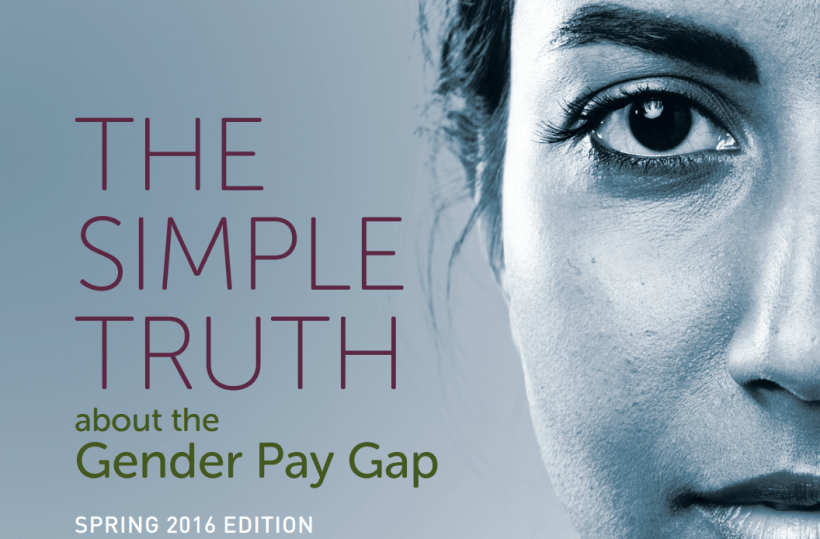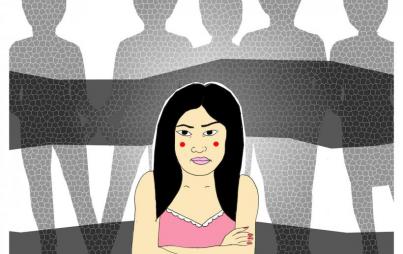
Bias against women employees accounts for as high as 40 percent of the pay gap. Image: AAUW/The Simple Truth about the Gender Pay Gap .pdf.
Despite our dependence on caregiving to grow and function as a society, compensation for this labor remains unfairly low.
April 12 is Equal Pay Day. Started in 1996 by the National Committee on Pay Equity (NCPE), the goal has always been to raise consciousness about the gap between women’s and men’s wages. (Just ask the U.S. Women’s Soccer Team how they feel about not getting paid fairly — they just filed a lawsuit with the Equal Employment Opportunity Commission.)
In conjunction with the yearly discussion, numerous studies have been released to parse the latest numbers, with economists putting forth steps that could ameliorate the circumstances.
In the midst of innumerable stats, there are a number of takeaways: Women are being pushed to lower-paying fields, their contributions to the workforce are undervalued, they must pay a price for caregiving responsibilities, and they are more likely to end up in poverty when they are older.

National policy has failed to address these inequities.
Although many are familiar with the figure stating that American women make 79 cents to a man’s dollar, that is actually the median earnings of a white woman to a white man’s dollar.
Too often lost in the general conversation is a breakdown of how the earnings of women of color stack up against that of a white man.
Numbers vary slightly between recent reports. The Joint Economic Committee (JEC) study “Gender Pay Inequality: Consequence for Women, Families and the Economy” showed that African-American women earned 60 percent of a white man’s dollar. Hispanic women earned 55 percent. Part of this is also the result of women of color being pushed to the lowest earning occupations — which I’ll get to shortly.
Back in 1963, President Kennedy passed the Equal Pay Act. A year later, the Civil Rights Act was put into play. It featured Title VII, which banned discrimination based on sex (along with race, color, national origin, and religion).
In 1963, 44 percent of women in the age bracket of 25-54 (“prime working age”) were in the labor force. Currently, 75 percent of women 25-54 are working, and they hold 49 percent of all jobs. 55 percent of married women work outside the home; 40 percent are primary breadwinners. Two-thirds of mothers with children under 18 are in the labor force as well.
From the period when a white woman is 18-24, the wage discrepancy is 88 percent. However, as she ages and moves to the mid-stage of her career (over 35), the gap reaches 76 percent.
Since 1979, women have outstripped men in college enrollment. However, the JEC report showed that women’s median earnings were lower regardless of their level of education.
In fact, women with a graduate degree earns $5,000 less than the “typical” man with a Bachelor’s degree.
There are numerous factors that add to the wage gap equation. One is the dearth of women in specific disciplines. Men vastly outstrip the numbers of women in STEM fields. Occupations in fields that are predominantly women pay less than those that are primarily men. This is called “occupational crowding” — basically occupational segregation.
For example, in the sector of law, where the salary is listed as $93,964 (U.S. Bureau of Labor Statistics), only 34 percent of the field is comprised of women. At the low end of the earnings scale, cashiers ⎯— who are 71 percent women — earn $20,488 annually. In contrast, those women cashiers earn 10 percent less than parking lot attendants (who are 92 percent men).
Occupations encompassing caregiving and nurturing the development of children have a majority of women workers. Only 20 percent of primary education employees are men.
Despite our dependence on caregiving to grow and function as a society, compensation for this labor remains unfairly low.
The “motherhood” penalty, which shows that women with children earn less than women without kids, is another factor. On the flip side, fathers get a “daddy bonus,” earning more than men without children. When women move out of the workforce to raise a family, it impacts their lifetime earnings.
The same holds true when women care for sick family members: Three out of every five caregivers to older adults are female. Upon returning, they have lost potential pay raises and advancement opportunities.
European countries such as France and Germany, recognize the time and effort that women give to the caregiving that often goes entirely unpaid. The Institute for Women’s Policy Research (IWPR) did a report looking at pension caregiver crediting in other countries in 2011.
When you combine all these factors, it leads to hundreds of thousands of dollars in lost earnings for women by age 65.
Estimates in the JEC report evidence that a white woman working full-time earns $10,800 less, annually, than her male counterpart. This accumulates to $500,000 over the span of a career. When it comes time to retire, the median income for a woman who is 65 or older is $17,400. For a man in the same grouping, it is $31,200 — a difference of 44 percent.
Most women depend on Social Security as their main form of retirement funds, as revenue from pensions or private savings are small to negligible. They also live longer and have more extensive medical expenses.
As a result, “at every age, women are more likely than men to live in poverty.”
Specifically, women are 1.6 times more likely than men to live in poverty by the time they reach 65, and two times more likely by the age of 75.
These are the distressing realities. What are the solutions?
Using public policy to rectify these inequities is a core approach.
The government needs to step up workplace protections. This includes paid family and medical leave, paid sick days, and paid maternity leave. (Yes, it’s true: the United States is the sole industrialized nation that does not guarantee paid parental leave.)
Universal child care and pre-K, tax breaks for caregivers, and flextime for women and men need to be priorities going forward. Companies need to restructure their places of work and implement policies to support families.
Furthermore, a passage of the Equal Rights Amendment would guarantee equality under the law.
The Paycheck Fairness Act was passed by the House of Representatives in 2009, but was defeated in the Senate the next year. Its mission was to achieve “compensatory and punitive damages” as well as back pay. It was reintroduced in 2015 by Sen. Barbara Mikulski (D-MD). GovTrack gives it a 1 percent chance of being enacted into law.
The studies I read were unanimous: It all comes down to discrimination.
After factoring in all the components, researchers still determined that bias against women employees accounted for as high as 40 percent of the pay gap. Resumes that were exactly the same were submitted to employers with the names of men and women. The male applicant was more likely to be offered the job.
“Women nationwide know the pay gap isn’t myth, it’s math, and it’s a reality they live with every day,” Lisa Maatz, Vice President of Government Relations at the American Association of University Women (AAUW), told me. “The pay gap results in lost wages for women and their families. That’s less money for a car, a house, an education, or retirement savings. At the rate we’re going, especially without the passage of the Paycheck Fairness Act, women won’t see equal pay for over 100 years.
“Women, their families, and the economy can’t wait.”








